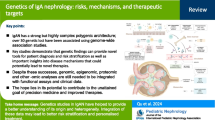Summary
To evaluate familial factors in the development of diabetic nephropathy in insulin-dependent diabetes mellitus (IDDM) we examined concordance for diabetic nephropathy in families with multiple IDDM siblings. Families (n=110) were identified through Joslin Clinic patients (probands) with a sibling having IDDM. To be eligible, the probands' and siblings' ages at IDDM diagnosis were less than 21 years, and IDDM duration was more than 15 years for probands and more than 10 years for siblings. Mean post-pubertal diabetes duration was 23 years for probands (n=110) and 21 years for siblings (n=125). Nephropathy history was determined by medical record review for deceased patients and those with persistent proteinuria or end-stage renal disease to ascertain the date of onset of persistent proteinuria. For patients without documented nephropathy, the albumin/creatinine ratio was measured in multiple urine samples. The cumulative incidence of persistent proteinuria according to post-pubertal duration of IDDM was determined by life-table analysis. For probands and siblings combined, the cumulative incidence of advanced diabetic nephropathy after 30 years of IDDM was 35%, but the risk in siblings varied according to the proband's renal status. The cumulative risk in siblings after 25 years of IDDM (post-puberty) was 71.5% if the proband had persistent proteinuria but only 25.4% if the proband did not (p<0.001). A difference of nearly 50% in the risk to IDDM siblings, depending upon the IDDM proband's renal status, is consistent with a major gene effect that predisposes an individual with IDDM to develop advanced diabetic nephropathy.
Similar content being viewed by others
Abbreviations
- IDDM:
-
Insulin-dependent diabetes mellitus
- C.I.:
-
confidence interval
References
Andersen AR, Christiansen PK, Andersen JK, Kreiner S, Deckert T (1983) Diabetic nephropathy in type 1 (insulin-dependent) diabetes, an epidemiological study. Diabetologia 25: 496–501
Krolewski AS, Warram JH, Christlieb AR, Busick EJ, Kahn CR (1985) The changing natural history of nephropathy in type I diabetes. Am J Med 78: 785–794
Krolewski AS, Warram JH, Rand LI, Kahn CR (1987) Epidemiologic approach to studies on etiology of IDDM and its complications. N Engl J Med 317: 140–145
Seaquist ER, Goetz FC, Rich S, Barbosa J (1989) Familial clustering of diabetic nephropathy. New Engl J Med 320: 1161–1165
Borch-Johnsen K, Norgaard K, Hommel E et al. (1992) Is diabetic nephropathy an inherited complication? Kidney Int 41: 719–722
Khoury MJ, Flanders WD, Greenland S, Adams MJ (1989) On the measurement of susceptibility in epidemiologic studies. Am J Epidemiology 129: 183–190
Risch N (1990) Linkage strategies for genetically complex traits. II. The power of affected relative pairs. Am J Hum Gen 46: 229–241
Barzilay J, Warram JH, Bak M, Laffel LMB, Canessa M, Krolewski AS (1992) Predisposition to hypertension: risk factor for nephropathy and hypertension in IDDM. Kidney Int 41: 723–730
Krolewski AS, Laffel L, Krolewski M, Quinn M, Warram JH (1995) Glycosylated hemoglobin and risk of microalbuminuria in IDDM. N Engl J Med 332: 1251–1255
Janner M, Eberhard Knill S, Diem P, Zuppinger KA, Mullis PE (1994) Persistent microalbuminuria in adolescents with type I diabetes mellitus is associated to early rather than late puberty. Euro J Pediatr 153: 403–408
Rothman KJ (1986) Modern epidemiology. Little Brown & Company, Boston
SAS Institute Inc. (1985) SAS/STATTM Guide for Personal Computers. Version 6 Edition. SAS Institute, Cary, NC
Diabetes Control and Complications Trial Research Group (1993) The effect of intensive treatment of diabetes on the development and progression of long-term complications in insulin-dependent diabetes mellitus. N Engl J Med 329: 977–986
Derby L, Warram JH, Laffel LMB, Krolewski AS (1989) Elevated blood pressure predicts the development of persistent proteinuria in the presence of poor glycemic control in patients with type I diabetes. Diabete Metab 15: 320–326
Microalbuminuria Collaborative Study Group, United Kingdom (1993) Risk factors of development of microalbuminuria in insulin dependent diabetic patients: a cohort study. BMJ 306: 1235–1239
Coonrod BA, Ellis D, Becker DJ et al. (1993) Predictors of microalbuminuria in individuals with IDDM. Diabetes Care 16: 1376–1383
Krolewski AS, Warram JH, Christlieb AR (1994) Hypercholesterolemia — a determinant of renal function loss and deaths in IDDM patients with nephropathy. Kidney Int 45:S125-S131
Quinn M, Krolewski AS (1995) Familial clustering of glycosylated hemoglobin (HbA1) in IDDM siblings. Diabetes 44[Suppl 1]:787A (abstract)
Ward R (1990) Familial aggregation and genetic epidemiology of blood pressure. In: Laragh JH, Brenner BM (eds) Hypertension: pathophysiology, diagnosis and management, vol 1. Raven Press, New York, pp 81–100
Morrison JA, Kelly K, Horvitz R et al. (1982) Parent-offspring and sibling lipid and lipoprotein associations during and after sharing of household environments: the Princeton School District Family Study. Metabolism 31: 158–166
Khoury MJ, Beaty TH, Liang KY (1988) Can familial aggregation of disease be explained by familial aggregation of environmental risk factors? Am J Epidemiol 127: 674–683
Hopper JL, Carlin JB (1992) Familial aggregation of a disease consequent upon correlation between relatives in a risk factor measured on a continuous scale. Am J Epidemiol 136: 1138–1147
Peto J (1980) Genetic predisposition to cancer. In: Cairns J, Lyon JL, Skolnick M (eds) Cancer incidence in defined populations. Banbury Report No. 4; Cold Spring Harbor Laboratory, Cold Spring Harbor, NY, pp 203–213
Reeders ST (1989) Genetic factors in diabetic nephropathy. New Engl J Med 321: 905 (Letter)
Krolewski AS, Doria A, Magre J, Warram JH, Housman D (1992) Molecular genetic approaches to the identification of genes involved in the development of nephropathy in insulin-dependent diabetes mellitus. J Am Soc Nephrol 3: S9-S17
Author information
Authors and Affiliations
Rights and permissions
About this article
Cite this article
Quinn, M., Angelico, M.C., Warram, J.H. et al. Familial factors determine the development of diabetic nephropathy in patients with IDDM. Diabetologia 39, 940–945 (1996). https://doi.org/10.1007/BF00403913
Received:
Revised:
Issue Date:
DOI: https://doi.org/10.1007/BF00403913




